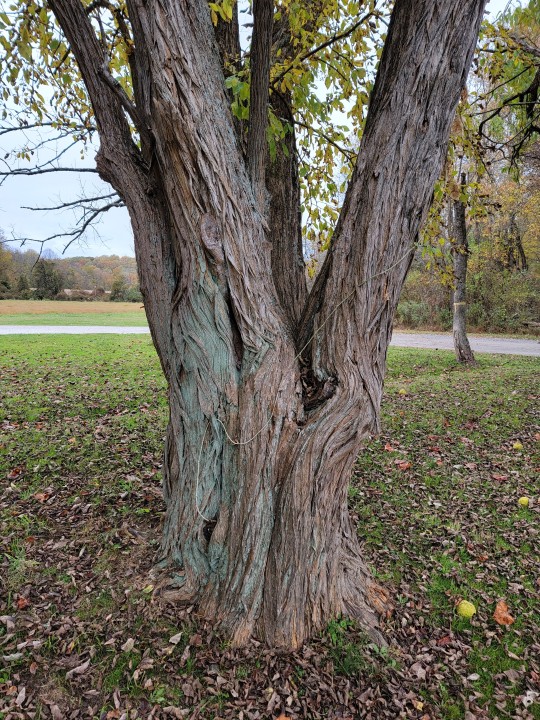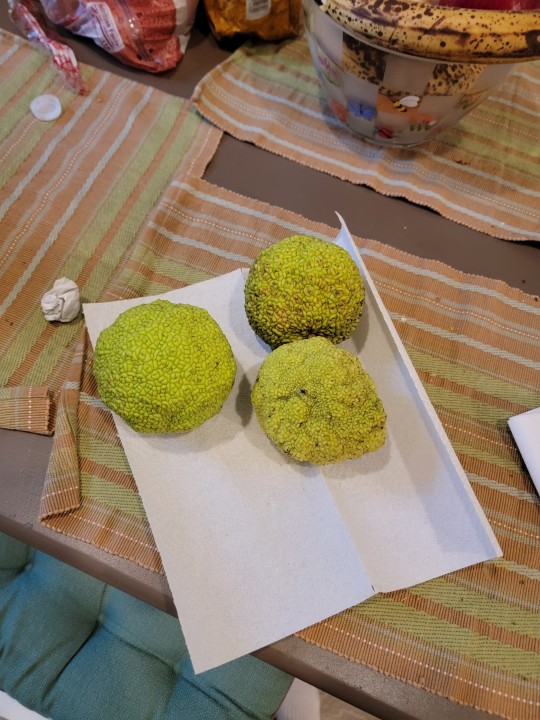#maclura pomifera
Explore tagged Tumblr posts
Text

Osage orange..
305 notes
·
View notes
Text
It's that time of year where the trees start growing brains again

8 notes
·
View notes
Text
Let us know when your paper is published!
complaint of a multi-modal scholar:
just gave a great presentation of my research today to my entire division at work. People only asked me about scicomm, art, comics, and social media.
EVERYONE wants to talk form, NO ONE wants to talk content
fer fucks sake, I just told a roomful of restoration scientists that our restorations are shit because there's no harvesting disturbance regime and our historic reference ecosystem baselines are therefore garbage fantasies. Argue with me!
it did go very well and people loved it, but no one will ever critically engage with my content. they just go "ooh pretty picture!" 🥲
183 notes
·
View notes
Text

also this add-on is so funny to me bc this just looks like Maclura pomifera/Osage-Orange

2 notes
·
View notes
Text
Fruit du Maclura pomifera appelé couramment oranger des Osages ou bois d'arc est un arbre d'origine nord-américaine appartient à la même famille que les mûriers. Le Maclura est monotypique, ce qui signifie qu'il n'en existe qu'une seule espèce. Il se développe naturellement dans le sud des États-Unis. Il tire son nom des Oranger des Osages, une tribu indienne qui utilisait le bois du Maclura notamment pour la confection des arcs et des haches. Sa couronne est large et plus ou moins aplatie. Étant donné ses branches très épineuses, il est souvent utilisé comme arbre de haie en Amérique du Nord. Ses feuilles sont de forme variable, bien que le sommet du limbe soit toujours longuement acuminé. Elles deviennent jaunes en automne. Il s'agit d'un arbre dioïque ; il existe donc des spécimens mâles et des spécimens femelles. Il faudra donc un arbre avec des fleurs mâles pour produire du pollen et une autre arbre qui produit des fleurs femelles. Si fécondé cette femelle peut portes des gros fruits ronds de la taille d'une belle orange. Sa floraison discrète est suivie de l'apparition de fruits aromatiques rappelant quelque peu les oranges. Leur peau verruqueuse est initialement jaune verdâtre et vire au jaune orangé par la suite. Résistance moyenne au froid. Le fruits n'est pas comestible étant extrêmement amer. Il y également le cudranier de chine ou mûrier chinois de son nom latin cudrania tricuspidata renommé de nos jours maclura tricuspidata, il a un développement en mode nonchalance, dont il faut savoir attendre et mûrir dans la placidité, être serein armé de cette vertu de la patience qui plus est sachez que les premières fructifications apparaissent au minimum au bout de 10 à 15 années de croissances à partir d'un fuseau ou d'un scion, de plus qui n'est point négligeable ses fruits plus petits et rougeâtres sont comestibles et succulents. Et un avantage il se greffe très bien sur le maclura pomifera l'oranger des Osage, le fait qu'ils sont de la même famille celui de moraceae. Ainsi de cette greffe rendra la fructification encore plus précoce et plus importante, en âge adulte produit plus d'une centaine de kilos.

8 notes
·
View notes
Text
oh my god, there's these trees in my area that drop a fruit on the ground that i've always called crabapples and i immediately thought of them as possibly being former ground sloth food... but i've had trouble finding their species in the past bc i couldn't find a crabapple that matches them.
so thank you for giving me a reason to go look again and find out that i've been calling osage oranges by the wrong name for my entire life (and they might have been, no conclusive science yet):
just learned that magnolias are so old that they’re pollinated by beetles because they existed before bees
388K notes
·
View notes
Text
The Strange Fruit Of The Osage Orange
The patterns on the fruit of the Osage orange are the reason I photographed them. Osage orange, (Maclura pomifera), also called bowwood, is a thorny tree or shrub native to the south-central United States. Its hard yellow-orange wood was used for bows and war clubs by the Osage and other Native American tribes (hence the name). Female flowers are borne in a dense, nearly spherical cluster and…

View On WordPress
0 notes
Text







9 notes
·
View notes
Text


Today let's talk about one of my favorite (and everyone else's least favorite trees) The Osage Orange Maclura pomifera
The Osage Orange is a pretty unique tree that comes from a previously wide spread variant of tree that has, within the last epoch, been disappearing. You may have noticed these lumpy unpalatable fruit on the ground inexplicably fallen from a tree left to rot as no species really eats them. This is because the animals of dispersal were Pleistocene megafauna (wooly mammoth, ground sloth, mastodon) things that have gone extinct since the last ice age. The fruit is actually poisonous to smaller animals so very large grazers were only capable of consuming these. Since their disappearance we have been left with very few examples of trees that cater to megafauna.
As for the tree itself the wood produces a beautiful yellow wood color and was only really known to Osage natives in the Central Texas region before European Colonization. Settlers utilized the wood for natural paddock fencing as younger branches produce incredibly thorny stems. Non-scientific media often urges us to force this tree into extinction (which it is in no danger of) as it's fruit is considered annoying and has no consumers, which is the most common discussion revolving around the tree online. That is frankly an incredibly stupid opinion I just wanted to make others aware. There is discussion of bringing this tree back in use of silvopasture but for now it makes a fun ornamental.
11 notes
·
View notes
Text
I'm convinced that fantasy authors other than G.R.R.M have used hedge knight to refer to low level knights, but internet searching is only showing me the references to that series.
Hedge apple is one of the hundred names for Maclura pomifera, at least for the fruit. It's such a weird tree. I love the thought of the plant that outlasted its megafauna, but found a new disperser in humans.
In looking for other names with hedge - Merriam Webster mentions hedge parson, hedge wedding and hedge tavern - which sounds like a good time to me.
I imagine a hedgecat is one of those small, stocky cats that lurk around farms. More independent than a barn cat. Like Mist, a cat I knew who would cycle around the neighborhood, having a litter (and a different name) at each farmstead.
Hedge is underused as a prefix for creatures.
Hedgehog: A small animal found in gardens with a similar, if miniature, behaviour as hogs. Hedgewitch: A small magic user found in gardens with a similar, if miniature, behaviour as witches.
We’re sitting on untapped potential for hedgewolf. Hedgewhale. Hedgegod. Hedgeknight. Does any of this make sense or do I just need to go to sleep.
10K notes
·
View notes
Photo

Scientific Name: Maclura pomifera Common Name(s): Osage-orange, bois d’arc, bodark, horse apple, hedge apple Family: Moraceae (mulberry) Life Cycle: Perennial Leaf Retention: Deciduous Habit: Tree USDA L48 Native Status: Native Location: Carrollton, Texas Season(s): Spring
Texas’s ugliest fruit is a harsh assessment.
#Maclura pomifera#Osage orange#bois d'arc#bodark#horse apple#Moraceae#perennial#deciduous#tree#native#Carrollton#Texas#spring#fruit#green#Osage-orange#plantblr
15 notes
·
View notes
Text
On the post about the Blue Haired Girlfriend's quixotic citrus breeding experiments, @voidingintotheshout asked:
I mean, if you wanted a hearty citrus relative, why didn’t you just grow Osage Orange? They can grow as far north as Michigan which is surely further north than anyone could reasonably expect to grow a citrus tree. They’re not edible but then hearty orange isn’t either. Osage Orange are so cool and such a interesting historical plant from the Shelterbelt era of American agriculture. Apparently they do smell like citrus.
We like growing things we can eat. We're a bit North of Michigan, but we could probably grow an Osage Orange here if we wanted to. They're a very cool tree (thanks for the excuse to talk about them!), but they're unrelated to citrus; and not only not edible by humans, they're mostly not edible by anything still walking the earth. The rock-hard lumpy neon green fruits evolved to be crunched by mammoths with molars 30 centimeters across, or maybe prehistoric horses or giant ground sloths.

(Photo by Gale French)
But their seed dispersers went extinct, and for a long time they grew only in the valley of the Red River, where the seeds spread mostly by floating around in the river and being bashed open on rocks.
They probably would have stayed on the river banks, waiting for the mammoths, were it not for the Dust Bowl. In the 1930s, farmers converted swaths of the North American Great Plains to agriculture, replacing deep-rooted native grasses with shallow-rooted crops. Then the wind just blew the unattached dusty dry soil into the air and away. These were the Black Blizzards, dust storms that blotted out the sun as far away as New York City and choked the streets with dust. Day was dark as night. Actual snow, when it fell, was stained red.
In 1934, American President Roosevelt ordered construction of the Great Plains Shelterbelt, a massive weather control machine. 200 million trees were planted to reduce the wind and increase moisture. The weather machine covered fifty thousand kilometers, in stripes hundreds of kilometers wide. Osage Oranges were widely used; they're great wind-eating trees. They grow well in shallow wind-eroded soil, and each plant grows multiple trunks, so they quickly become dense thorny thickets.
Humans building massive weather control machines are actually pretty good mammoth substitutes, and once again Osage Orange thickets cover large chunks of North America, baffling human and squirrel alike with their useless ghost-eaten fruits. Nearly a century later, the Shelterbelt is getting a little ragged in places, but it still holds back the winds.
474 notes
·
View notes
Photo


Osage orange (Maclura pomifera) and fruit of flowering quince (Chaenomeles sp.)
#Maclura pomifera#Chaenomeles#fall fruits#fruits#Osage orange#quince#flowering quince#fall#botany#phytocurious#trees and shrubs
106 notes
·
View notes
Text
Non 'Cosa sono quei frutti' ma cosa sto facendo.
Comunque, una volta avevo due capre (Agata e Roxie) che per una serie di sfortunati eventi - mastite con sepsi eʿīd al-aḍḥā (così han sentenziato le forze dell'ordine) - adesso non ci sono più e quindi la natura si è ripresa lo spazio del loro recinto, allora ripulito e fertilizzato.
In un boschetto denso di querce, robinie, meli, prugni, berretti da prete, prugnoli, forsizie e decine di altre piante, ho cominciato a buttare semi e frutti di ogni genere, creando così una specie di microcosmo protetto per animali (caprioli, tassi, ricci, istrici, vari passeriformi/fringuellidi e gatti) nonché una selva dove adesso stanno attecchendo noccioli, noci, peschi, albicocchi, cachi e perché, no...
Alberi di MACLURA POMIFERA.
Saprò aggiornarvi al momento adatto.

INDOVINELLO DEL GIORNO
Cosa sto facendo?
(Il vincitore si aggiudicherà il nome su quello che sto facendo)
36 notes
·
View notes
Photo


Osage orange (Maclura pomifera)
#Osage orange#hedge apple#horse apple#bois d'arc#bodark#bow-wood#yellow-wood#mock orange#Plantae#Angiosperms#Eudicots#Rosids#Rosales#Moraceae#Maclura#Maclura pomifera#Nikon D3400#nikonphotography#my flora#nature photography#photographers on tumblr#Ioxylon pomiferum#Joxylon pomiferum#Maclura aurantiaca#Toxylon aurantiacum#Toxylon maclura#Toxylon pomiferum#trees of the Great Lakes region (North America)#trees of the North-Central United States#trees of the Northeastern United States
2 notes
·
View notes
Photo

Maclura pomifera
Osage Orange, Hedge Apple, Bodark
While the seeds are edible, this tree's primary draw is it’s wood, which is prized in bow-making. Neat.
(via)
#Maclura pomifera#Maclura#Osage Orange#Hedge Apple#Bodark#fruit#lumpy#edible parts#edible#wood#other facts#green
13 notes
·
View notes